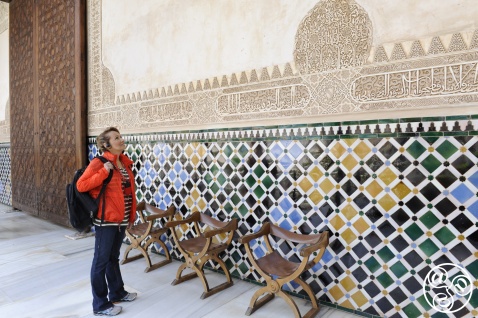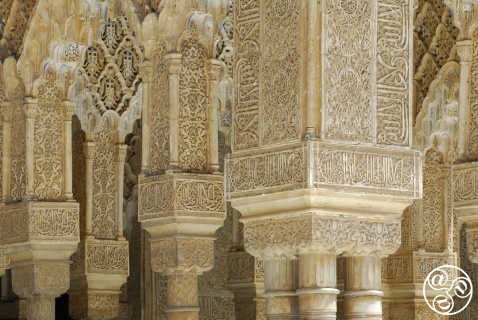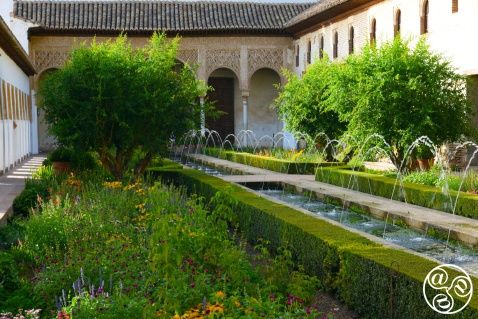
Discover the Alhambra your way with a self-guided tour itinerary that lets you linger, explore, and take it all in at your own pace © Michelle Chaplow |
|
Self Guided Alhambra Tour itinerary – arrival by Car.
by Chris Chaplow
Having parked your car in the main car park, walk to the ticket office complex where the entrance is located. There are two lines, one for individual ticket holders and another for groups. Your allocated entry time for the Nasrid palaces will be on your ticket - it will comfortably take about half an hour from here to the palaces’ entrance.
If you have time, there is a visitor centre containing a book and souvenir shop, and beneath the ticket hall are toilets, vending machines and left luggage lockers.
Practical information about Alhambra visiting times and Alhambra tickets
Entrance
At the entrance to the Alhambra complex, your ticket is scanned and your name checked against your ID. Walk through gardens that gently slope downhill and, after 5 minutes, you will reach a turning to the ‘new bridge’ on the right-hand side.
Most people visit the Alhambra palaces first and the Generalife afterwards, but if you still have more than 90 minutes to go before your time slot to enter the Nasrid palaces, you may choose to go through the Generalife gardens first. If so, continue walking straight on. If going to the Alhambra first, turn left over the new bridge.
Alhambra alta
You are now at Alhambra Alta. Walking down the footpath from the bridge, you will see on your left a gate in the wall called Puerta de los Siete Suelos (Gate of the Seven Floors, or Levels). It is so called because it was originally protected by a larger external gate, similar to the Puerta de la Justicia, which had seven "steps".
You will also walk by the ‘city of the Alhambra’ - medina al-Hamrat – which was excavated in the nineteenth century, revealing the foundations of luxury homes, some of which had their own baths.
Monastery of San Francisco
Passing a control point, leave the gardens to enter a free public access area. On the right is the Monastery of San Francisco, now a Parador Hotel. If you have time, go in for a look at the public areas.
Walking down the path, on the right are the Moorish Baths followed by the Church of St Mary.
On the left are some souvenir shops with refreshment opportunities, and an information office. Also on the left is the Puerto de la Justicia (Justice Gate), where visitors arriving directly from the city will enter the site.
Palace Entrance area
Now you have arrived at the palace entrance area, where there is a toilet block and vending machines in a out-building. This will be your last chance for refreshment or to use the toilets for about another hour. If you are close to your ticket time slot, proceed directly to the entrance queue for the Nasrid palaces. There are usually two control points; at the first, your ticket is checked to ensure you are arriving at the correct time, and at the second, the ticket is scanned and your ID checked to admit you.
If you still have some time, you can also pass through the Puerto de Vino (Wine Gate) into the Alcazaba courtyard and see the Torre de la Vela and the Bell Tower.
You can also visit the Palace of Carlos V (the imposing square-shaped Renaissance building on the right-hand side. There is also an Alhambra Museum
NASARID PALACES
The Nasrid palaces consist of three parts; Mexuar, Serallo (including Palacio de Comares) and Harem (including Palacio de los Liones). In the tour, this is followed by the Emperor’s rooms, built after the reconquest for King Charles V.
MEXUAR
The first room you visit is the Sala de Mexuar, a reception room complete with a small oratory (prayer room). From here, you pass the small Golden Room and its patio.
PALACIO DE COMARES
From this point, only ministers or special dignitaries would enter deeper into the Palacio Árabe (Arab palace), or Casa Real, by a small door and corridor leading into the Patio de los Arrayanes (Court of the Myrtles). This is also called the Patio de la Alberca (Court of the Blessing or Court of the Pond), from the Arabic birka, meaning "pool".
You will notice that the pool divides the courtyard into two sides and is fed by a fountain at each end. The pool is full of goldfish and has myrtles growing along its sides, the fruit, leaves and branches of which are used to make medicine. Around the outside of the patio are chambers; the most important are on the north side and form the Comares Palace, the official residence of the King.
The inside of the Comares Palace provides a great angle to take photos of the pool outside. You can then exit the Palace by the same door and walk along the far side of the patio to take photos looking back down the 34m pool to the court; this is one of the most distinct and popular views of the Alhambra.
CASA REAL & PALACE DE LOS LIONES
Leaving by a side chamber, you will enter perhaps the most beautiful part of the famous Alhambra; the construction of these Royal Palaces dates back to the fourteenth century and is the work of two great kings: Yusuf I and Muhammed V. We first pass through the Patio of the Lions.
The centrepiece of the court is the Fountain of the Lions, which offers another classic photo opportunity. It comprises an alabaster basin supported by the figures of twelve lions in white marble. At the edge of the great fountain is a poem written by Ibn Zamrak which praises the beauty of the fountain and the power of the lions, but also provides an account of the ingenious hydraulic systems by which the fountain functioned.
There is a series of important rooms around the patio. The Sala de los Mocárabes is on the west side from which you entered; the Sala de Abencerrajes is to the south; the Sala de los Abencerrajes (Hall of the Abencerrages) derives its name from a legend according to which the father of Boabdil, the last sultan of Granada, having invited the chiefs to a banquet, massacred them here. This room is a perfect square, with a lofty dome and trellised windows at its base. The roof is decorated in blue, brown, red and gold, and the columns supporting it branch out beautifully into the ceiling’s arches.
The Sala de los Reyes is next visited on the eastern side of the court, before you return back past the lions and leave through the Sala de las Dos Hermanas on the north side.
The Sala de las Dos Hermanas (Hall of the Two Sisters) is named after the two white marble slabs laid as part of the pavement, which each measure 500 by 220 cm. There is a fountain in the middle of this hall and a magnificent ceiling - a dome honeycombed with tiny cells, all different, said to number 5000.
The Salón de los Embajadores (Hall of the Ambassadors) is the largest room in the Alhambra and occupies all the Torre de Comares Comares Tower . It is a square room with a 23m high domed ceiling. This was the grand reception room, and the throne of the Sultan was placed opposite the entrance.
Rooms of Carlos Quinto
After visiting the Palace of the Lions, you will pass through a Christian addition to the Alhambra, known as the Rooms of Carlos Quinto<, built between 1528 and 1537.
Passing along a wooden balcony with open views to Albaicín opposite, you can then descend the staircase into the Patio de la Reja, with its cooling fountain. Next door, in the cloisters of the gardens of the Patio of Lindaraja, there are a number of welcomed benches. This patio is the last room of the the Nasrid Palaces, where a drinking water fountain waits for you outside.
Jardines del Partal
Back outside, relax a little and enjoy the flowers in the Jardines del Partal (Partal Gardens). El Partal comes from an Arabic word meaning "the portico". Torre de las Damas is the picturesque arcade and tower with a pond just in front of it.
From Jardines del Partal, you can return along Paseo de las Torres, which follows the castle wall to exit by the new bridge. Here, you can turn left to visit the Generalife or turn right to return to the ticket office and car park.
Leaving Jardines del Partal, you can also bear right and return to exit near Palacio Carlo V if you are interested in seeing that and the Alcazaba (which you may not have had time to see before entering the Nasrid palaces).
Generalife Palace
Visiting the Generalife will take about an hour. It was formerly the ‘country retreat’ for the Arab rulers and is a small white palace nestled in the trees on El Cerro del Sol, a south facing hill near the Alhambra Palace. It was not a summer palace, but rather a refuge where rulers could hide from the clamouring demands of their subjects. The visit first passes through twentieth-century gardens.
You will notice the open air auditorium (where the Granada music festival is held every summer); stroll through the rose gardens and enter the Generalife in the same courtyard where visitors arrived. There is another ticket and ID control point. Climb the stairs up to the legendary Patio de la Acequia for another golden photo opportunity.
After leaving the Generalife Palace and passing the iron turnstile, turn right for the direct route through the gardens to leave the complex. Alternatively, if you have 15 minutes and enough stamina, turn left and climb the Escalera del Agua (water staircase), where the two stone banisters have been hollowed out to become refreshing water canals.
Both routes then lead back to the ticket office and the car park via a gentle stroll through the woods.
Hill of the Martres
The Hill of the Martyrs located to the south of the car park, was given its name by the Catholic monarchs because many Christian captives suffered and perished in the Moorish dungeons on this site. A Carmelite monastery was later founded here and, in the nineteenth century, the monastery was demolished to make room for a villa and gardens in the Romantic style. It is a quiet place to complete the tour you have just undertaken.
Buy your copy of - Granada, City of My Dreams
 Granada, City of My Dreams: An Historical and Artistic Guide to Granada and its Moorish Palace the Alhambra
Granada, City of My Dreams: An Historical and Artistic Guide to Granada and its Moorish Palace the Alhambra
This itinerary was written for Andaluca.com by Lawrence Boheme author of “Granada, City of My Dreams”. For, what fascinates us about this universal city is not only its monuments but its marvellous story, “the encounter between Moor and Christian, gypsy and Jew, medieval and Renaissance, glistening snow and Mediterranean sun. Lawrence Bohme, poet, illustrator and curious traveller, has filled these pages with luminous descriptions and drawings, the culmination of forty years of wanderings through the palaces and labyrinths. Amazon.co.uk or Amazon.es
Hotels within the Alhambra's grounds
Hotels within the Alhambra's grounds
Hotels next to the Alhambra
Hotels next to the Alhambra






